Your Guide to Learn Countries of Africa
The definitive guide to learn countries of Africa. Explore all 54 nations with an A-Z list, capitals, flags, and maps to master African geography fast.
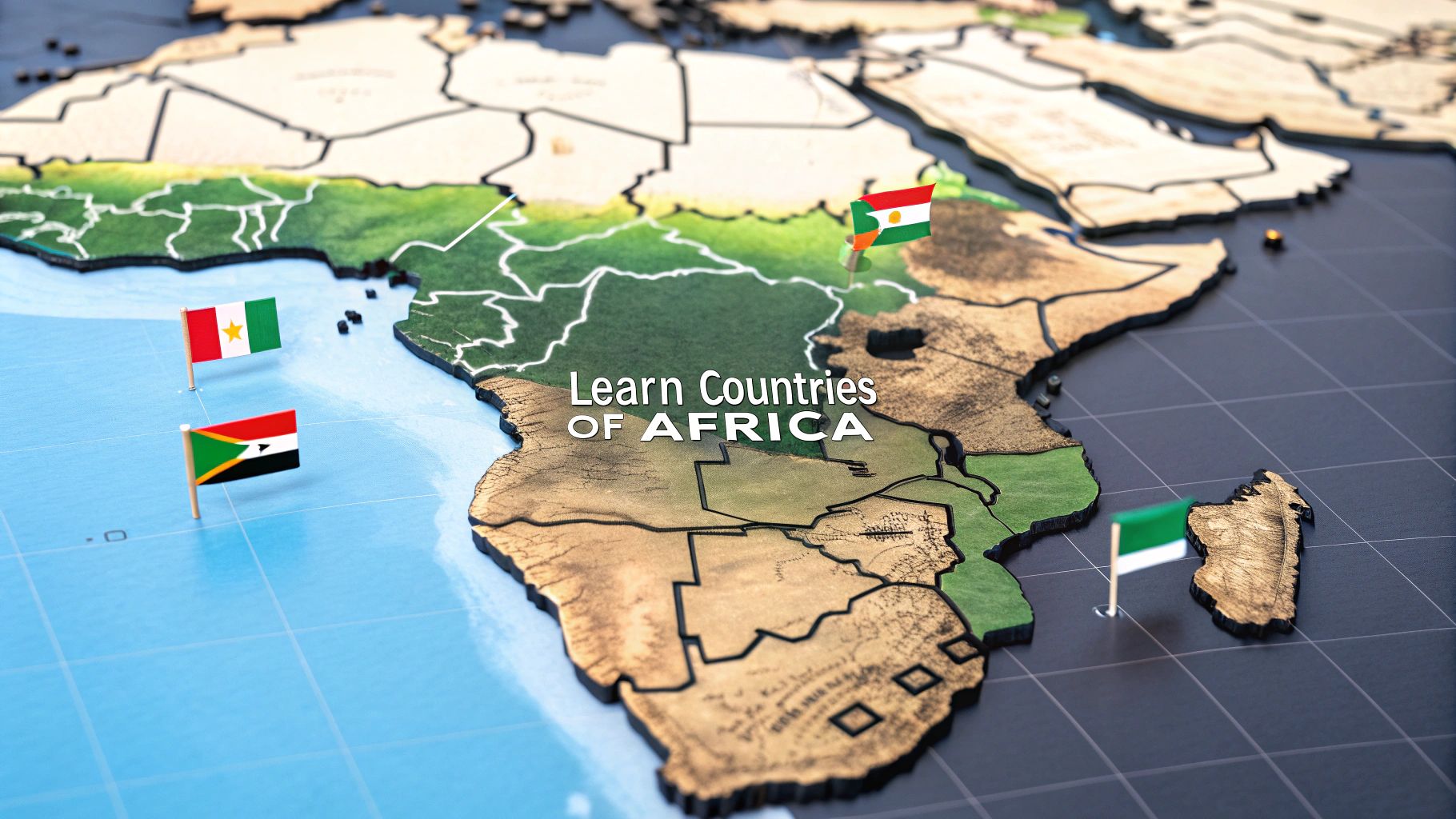
Learning all 54 sovereign nations of Africa can feel like a huge task. The key isn't just brute force memorization; it's about having a smart, structured approach. This guide is designed to be your go-to reference, breaking down the continent into easy-to-digest regions—perfect for students, geography buffs, or anyone curious about this incredible continent.
Your Essential Guide to African Nations
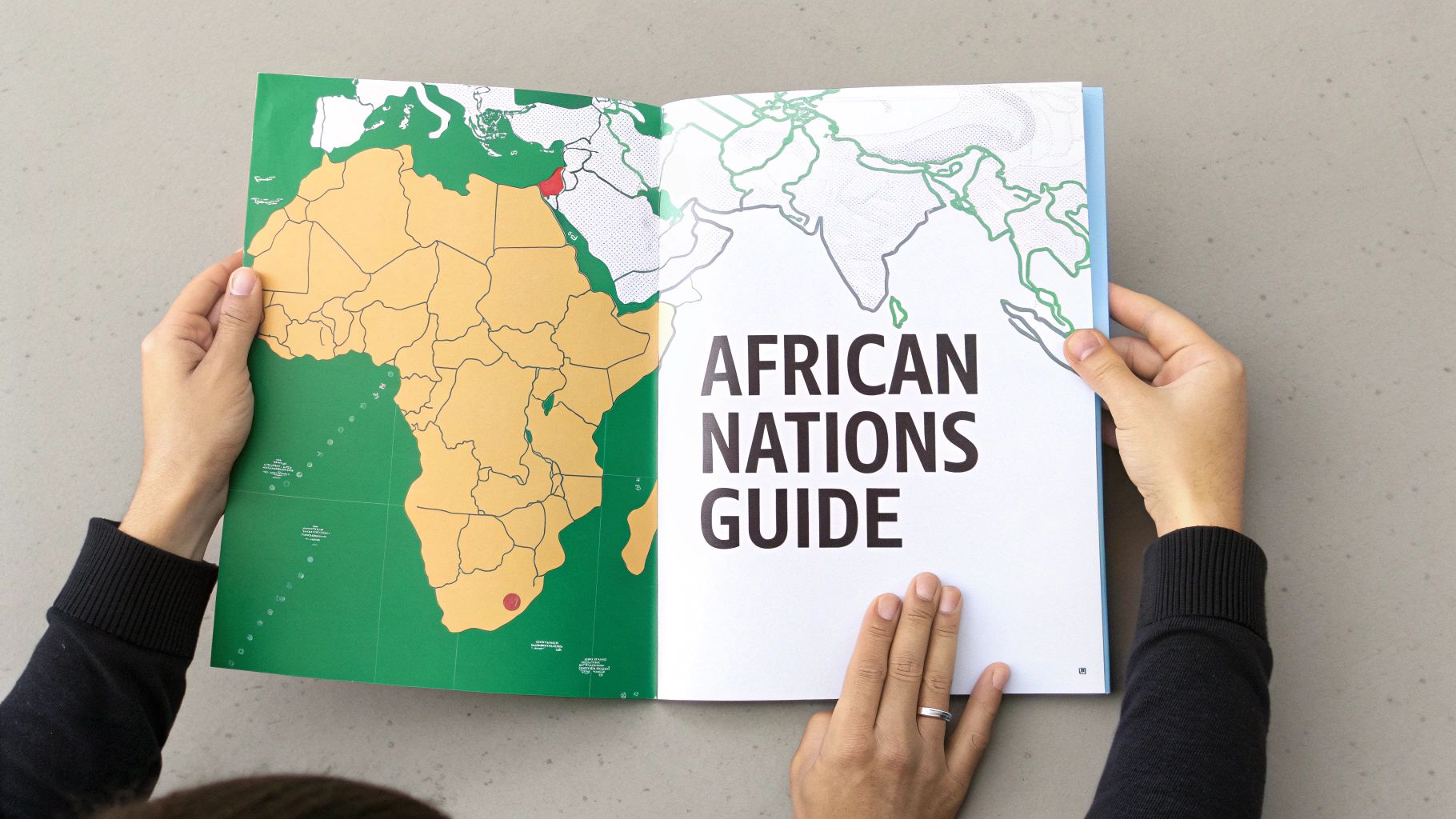
Welcome! You've found your comprehensive reference for mastering African geography. My goal here is to make learning the continent's countries as straightforward as possible. We'll do this by organizing all the nations by region, which is a much more effective way to learn than just tackling a long alphabetical list.
This method works because it groups countries that share geographical and cultural ties. Instead of trying to memorize 54 nations all at once, you'll focus on smaller, more manageable clusters. It just makes the information stick.
Why Regional Grouping Works
Learning geography is all about building mental maps. When you study Africa in sections, you naturally start to create stronger connections between neighboring countries, making the whole picture clearer. This guide is built around five distinct geographical regions to give you that essential context and make learning feel more intuitive.
- North Africa: The bridge between the continent and the Middle East.
- West Africa: A populous region with a rich history of powerful empires and trade.
- Central Africa: Famous for its immense rainforests and incredible biodiversity.
- East Africa: Home to iconic landscapes, from the Serengeti to the Great Rift Valley.
- Southern Africa: A region of remarkable geographical and economic diversity.
For every country, you'll find details on its capital, flag, and other key facts to build a complete profile. This approach is a core principle in effective learning, and you can dive deeper into these strategies in our full guide on how to learn world geography. We'll cover the essential data points for each nation and explain why they matter for a well-rounded understanding.
Exploring the Countries of Northern Africa
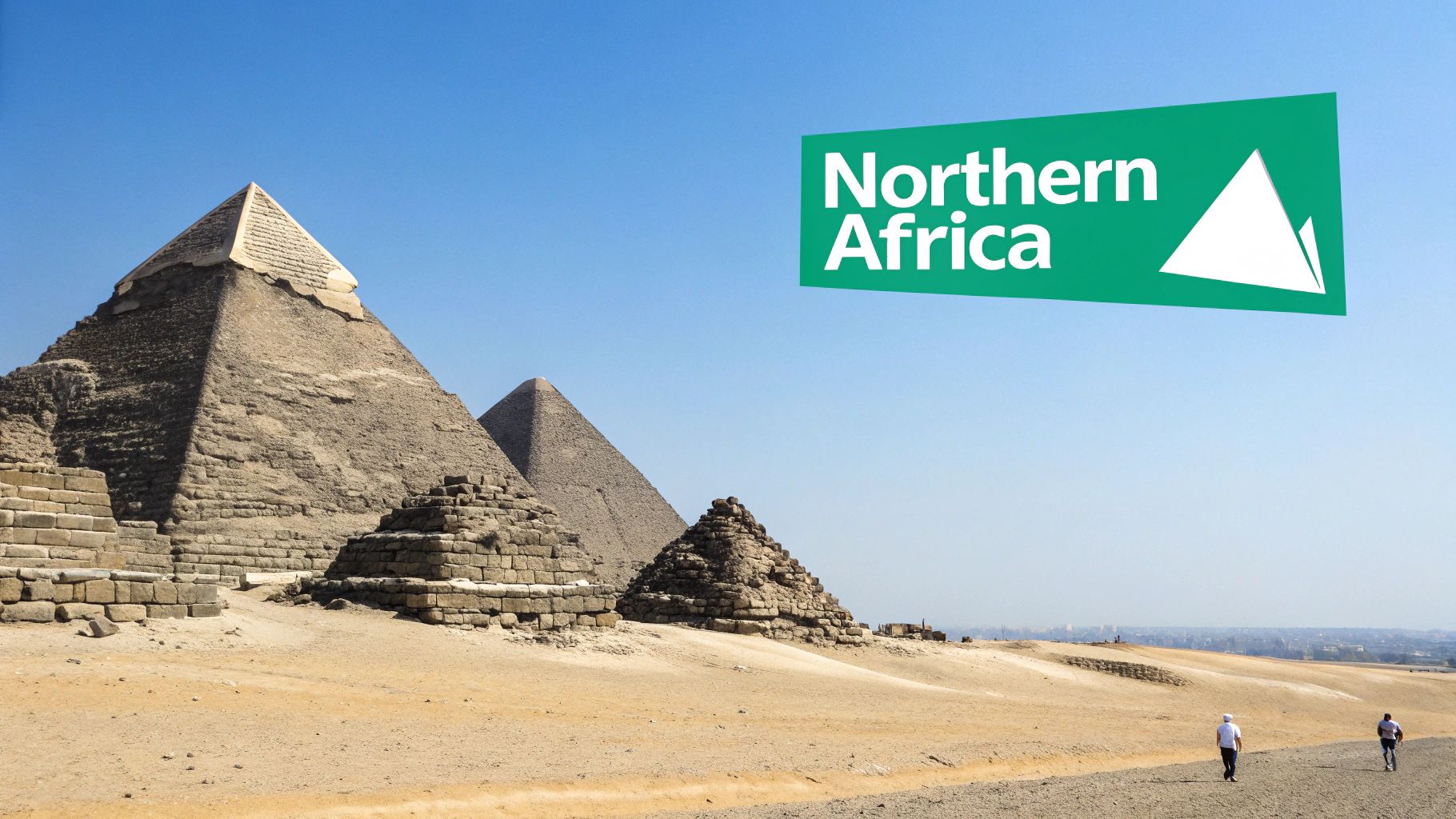
We'll kick off our continental tour in Northern Africa, a region dominated by the immense Sahara Desert and linked for millennia to the Mediterranean and the Middle East. It’s a fantastic place to start, offering a deep well of ancient history alongside vibrant, modern cultures.
To keep things simple and easy to reference, we’re going to tackle each country alphabetically. This approach helps you quickly find what you're looking for and draw connections between a nation and its essential facts—like the capital, flag, and population.
Algeria
Algeria is a giant; in fact, it’s the largest country in Africa by land area, with a huge portion of its territory swallowed by the Sahara. Its capital, Algiers, is a historic port on the Mediterranean coast famous for its whitewashed Casbah. The nation is home to over 45 million people.
Egypt
Egypt needs little introduction, famous for its incredible ancient civilization and iconic monuments like the Giza pyramids and the Great Sphinx. Its massive capital, Cairo, pulses with energy along the Nile River and stands as the largest city in the Arab world. With a population exceeding 114 million, it's one of Africa's most populous countries.
Libya
Libya boasts the longest Mediterranean coastline in North Africa, a defining feature of its geography. Its capital is Tripoli, a city whose history stretches all the way back to the Phoenicians. The country is mostly desert, which is why most of its roughly 7 million residents cluster along the coast.
Key Learning Tip: A great trick for making facts stick is to link a country to one standout feature. For instance, connecting Egypt with the Nile River or Algeria with its status as Africa's largest nation creates a powerful mental anchor that's hard to forget.
Morocco
Morocco is a country of vibrant contrasts, from its buzzing souks and imperial cities to the breathtaking Atlas Mountains. Its official capital is Rabat, but its largest and most famous city is Casablanca. With a population of about 38 million, Morocco is just a stone's throw from Europe, separated only by the narrow Strait of Gibraltar.
Sudan
Situated at the crossroads of North and sub-Saharan Africa, Sudan is a land of rich diversity. Its capital, Khartoum, is strategically located right where the Blue and White Nile rivers merge into one. Sudan has a population of around 49 million people and a history that reaches back to the ancient kingdom of Nubia.
Tunisia
Tunisia holds the distinction of being Africa’s northernmost country. Its long Mediterranean coastline has made it a hub of trade and culture for centuries. The capital, Tunis, is right next door to the ancient ruins of Carthage. Today, the nation has a population of about 12.5 million.
Exploring the Countries of West and Central Africa
Embedded content
Alright, let's continue our journey across the continent. This time, we're tackling two dynamic and distinct regions at once: West and Central Africa.
Grouping them like this gives you a broader perspective and makes it easier to learn the countries of Africa in bigger, more manageable chunks. We'll start with Western Africa, a hugely diverse and populous area with a deep, rich history, before heading into the continent's green heart.
West African Nations
Western Africa is where you'll find some of the continent's most populated and economically powerful countries. The geography here is a story of contrasts, stretching from the arid Sahel in the north down to lush tropical forests along the coast.
Let’s kick off our alphabetical tour of this vibrant region.
- Benin: Capital is Porto-Novo. A nation known for its history as the site of the formidable Kingdom of Dahomey.
- Burkina Faso: Capital is Ouagadougou. This landlocked country in the Sahel region has a name that means "Land of Incorruptible People."
- Cabo Verde: Capital is Praia. It's not on the mainland but is an archipelago of 10 volcanic islands off Senegal's coast.
- Côte d'Ivoire (Ivory Coast): Capital is Yamoussoukro. A global powerhouse in agriculture, it's one of the world's top producers of cocoa beans.
- The Gambia: Capital is Banjul. The smallest country on mainland Africa, it’s a sliver of land almost completely surrounded by Senegal.
- Ghana: Capital is Accra. Known for its stable democracy and incredible cultural heritage, including the famous Kente cloth.
- Guinea: Capital is Conakry. This country is a treasure trove of mineral resources, especially bauxite.
- Guinea-Bissau: Capital is Bissau. A small nation on the Atlantic with a complex network of rivers and islands.
This systematic approach provides a clear path to getting a handle on the geography of West Africa.
More Countries in West Africa
Moving on, this next set of nations includes some of Africa's biggest players in terms of population and culture. Nigeria, for instance, isn't just a regional giant; it's the most populous country in all of Africa.
As of 2025, its population is estimated to be around 237 million people, with Ethiopia and Egypt coming in second and third. This kind of rapid growth brings both massive opportunities and significant challenges. For anyone interested in the numbers, you can dive deeper into Africa's population stats on Worldometers.
Here are the remaining West African countries:
- Liberia: Capital is Monrovia. It holds a unique status as one of the few African nations that was never colonized by a European power.
- Mali: Capital is Bamako. A vast, landlocked nation that was once home to the legendary city of Timbuktu.
- Mauritania: Capital is Nouakchott. Spanning both the Sahara and the Sahel, it serves as a natural bridge between North and West Africa.
- Niger: Capital is Niamey. Another huge, landlocked country that gets its name from the vital Niger River.
- Nigeria: Capital is Abuja. The continent's economic powerhouse and most populous nation.
- Senegal: Capital is Dakar. Famous for its bustling arts scene and for being the westernmost point of the African mainland.
- Sierra Leone: Capital is Freetown. A coastal country known for its diamond production and excellent natural harbors.
- Togo: Capital is Lomé. This narrow country on the Gulf of Guinea is recognized for its beautiful palm-lined beaches.
Central African Nations
Now, let's shift our focus to Central Africa, often called the green heart of the continent. The entire region is dominated by the Congo Basin, which is home to the second-largest tropical rainforest on Earth.
Learning Tip: A great way to remember the countries of Central Africa is to link them to the Congo River system. Many nations here, like the two Congos, are directly tied to this massive and essential waterway.
- Cameroon: Capital is Yaoundé. People often call it "Africa in miniature" because it packs such an incredible amount of geographical and cultural diversity into one country.
- Central African Republic: Capital is Bangui. A landlocked nation with rich deposits of diamonds, gold, and other minerals.
- Chad: Capital is N'Djamena. A vast, mostly arid country named after Lake Chad, a critical water source for the entire region.
- Democratic Republic of the Congo: Capital is Kinshasa. By area, it's the second-largest country in Africa and possesses immense natural resources.
- Equatorial Guinea: Capital is Malabo. Though small, it's a wealthy nation and holds the distinction of being the only Spanish-speaking country in Africa.
- Gabon: Capital is Libreville. This country is a leader in conservation, known for its extensive network of national parks and protected rainforests.
- Republic of the Congo: Capital is Brazzaville. It sits on the western side of the Congo River, directly across from Kinshasa.
- São Tomé and Príncipe: Capital is São Tomé. A tiny island nation in the Gulf of Guinea, historically famous for its high-quality coffee and cocoa.
Exploring the Countries of East and Southern Africa
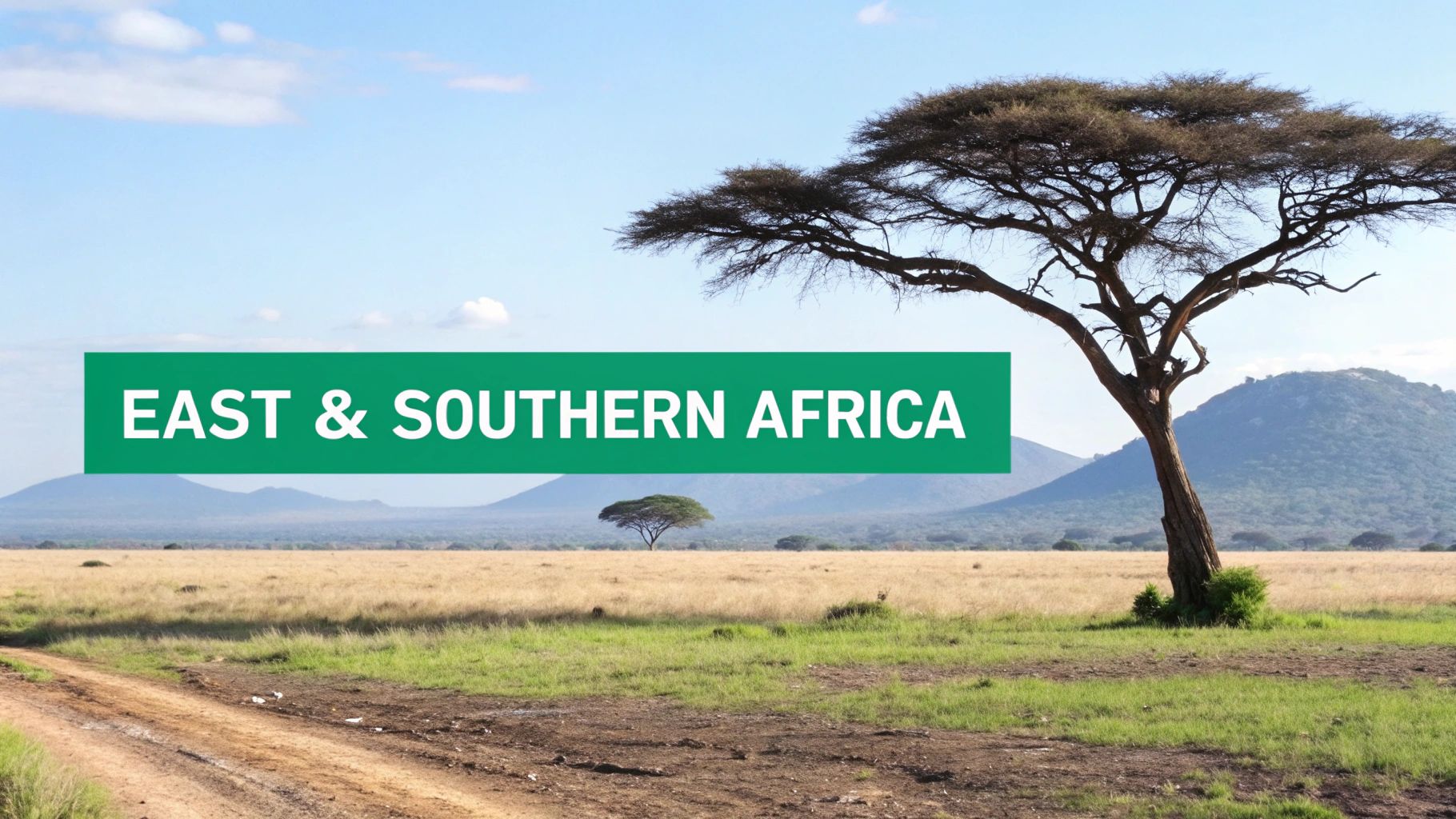
Our continental tour now brings us to the breathtaking landscapes of East and Southern Africa. This is the final leg of our regional breakdown, covering everything from the Serengeti plains to the roaring Victoria Falls. Using this structured approach helps you learn countries of Africa in a way that’s logical and much easier to remember.
We'll kick things off in Eastern Africa, a region carved out by the Great Rift Valley and home to some of the world's most famous wildlife reserves. For every country, you’ll find its capital, flag, and other key details laid out in a consistent format, making it simple to compare and learn.
Eastern African Nations
This region is where you'll find many of the continent's most recognizable landscapes alongside some of its fastest-growing economies. Listing these countries alphabetically makes for a quick reference and helps you build a solid mental map of the area.
- Burundi: The capital is Gitega. A small, densely populated nation, it’s often called the "Heart of Africa" for its central location.
- Comoros: An archipelago nation in the Indian Ocean with its capital at Moroni, it stands as one of Africa’s smallest countries.
- Djibouti: Its capital, Djibouti City, gives this small country a hugely strategic position on the Bab-el-Mandeb strait.
- Eritrea: The capital is Asmara, a city renowned for its stunning and well-preserved modernist architecture from the early 20th century.
- Ethiopia: Home to Addis Ababa, often called the political capital of Africa because it hosts the African Union headquarters.
- Kenya: The capital is Nairobi. Kenya is world-famous for its sweeping savannahs and incredible wildlife diversity.
- Madagascar: This massive island nation, with its capital at Antananarivo, is a biodiversity hotspot with countless species found nowhere else on Earth.
- Malawi: The capital is Lilongwe. Life in Malawi is dominated by Lake Malawi, one of the largest and deepest lakes in the world.
Keeping the layout consistent like this really simplifies the learning process, making it much easier to connect each nation with its core facts.
More Countries in Eastern Africa
As we continue our journey, we run into more of the nations that make this region so incredibly diverse. One of the most defining features of the entire continent is its demographic makeup.
Africa's population is remarkably young. Roughly 60% of Africans are aged 24 or younger, making it the world's youngest continent by a wide margin. This youthful dynamic is fueled by high fertility rates and contributes to its rapid growth.
This youthful energy is both a massive opportunity and a serious challenge, especially when it comes to providing education and jobs. While many nations are developing quickly, they often struggle to meet the needs of their growing populations. You can dive deeper into these dynamics to understand the continent's demographic trends.
- Mauritius: An island nation known for its stunning beaches and coral reefs, its capital is Port Louis.
- Mozambique: With Maputo as its capital, this country boasts a long Indian Ocean coastline dotted with popular beaches.
- Rwanda: The capital is Kigali. Known as the "Land of a Thousand Hills," it’s celebrated for its beautiful scenery and remarkable story of recovery and development.
- Seychelles: This archipelago of 115 islands has its capital at Victoria and is a world-renowned tourist destination.
- Somalia: The capital is Mogadishu. It has the longest coastline on mainland Africa.
- South Sudan: Africa's newest country, with its capital at Juba.
- Tanzania: The official capital is Dodoma. This country is home to Africa's highest peak, Mount Kilimanjaro.
- Uganda: The capital is Kampala. Nicknamed the "Pearl of Africa," it’s known for its lush, diverse landscapes and abundant wildlife.
- Zambia: The capital is Lusaka. This landlocked nation is famous for being home to the spectacular Victoria Falls.
- Zimbabwe: Its capital is Harare. The country also shares Victoria Falls and is known for its diverse wildlife reserves.
Southern African Nations
Finally, we arrive in Southern Africa, a region of incredible geographical and economic diversity.
- Angola: The capital is Luanda, a major port city on the Atlantic coast.
- Botswana: Its capital is Gaborone. The country is widely respected for its stable democracy and the vast Kalahari Desert.
- Eswatini (formerly Swaziland): It has two capitals, Mbabane (executive) and Lobamba (legislative).
- Lesotho: This mountainous kingdom, with its capital at Maseru, is an enclave entirely surrounded by South Africa.
- Namibia: The capital is Windhoek. It is famous for the towering, ancient red dunes of the Namib Desert.
- South Africa: This nation uniquely has three capitals: Pretoria (administrative), Cape Town (legislative), and Bloemfontein (judicial).
Quick Reference Table of All African Countries
When you're trying to learn all the countries of Africa, having a single, consolidated reference is a game-changer. This is your go-to spot for a quick review. We've pulled together all 54 nations into one easy-to-use list below, making it perfect for self-testing or just solidifying what you've learned.
Think of this table as the perfect cross-reference to the more detailed regional guides. Everything is organized alphabetically, pairing each country with its capital city, geographical region, and a recent population estimate. It's a fantastic way to quickly check a fact or reinforce the connection between a nation and its core data. If you want to put your memory to the test, try filling out a printable blank map of Africa to see what you can recall.
To give you a quick visual, this infographic shows the population figures for Africa's three most populous nations.
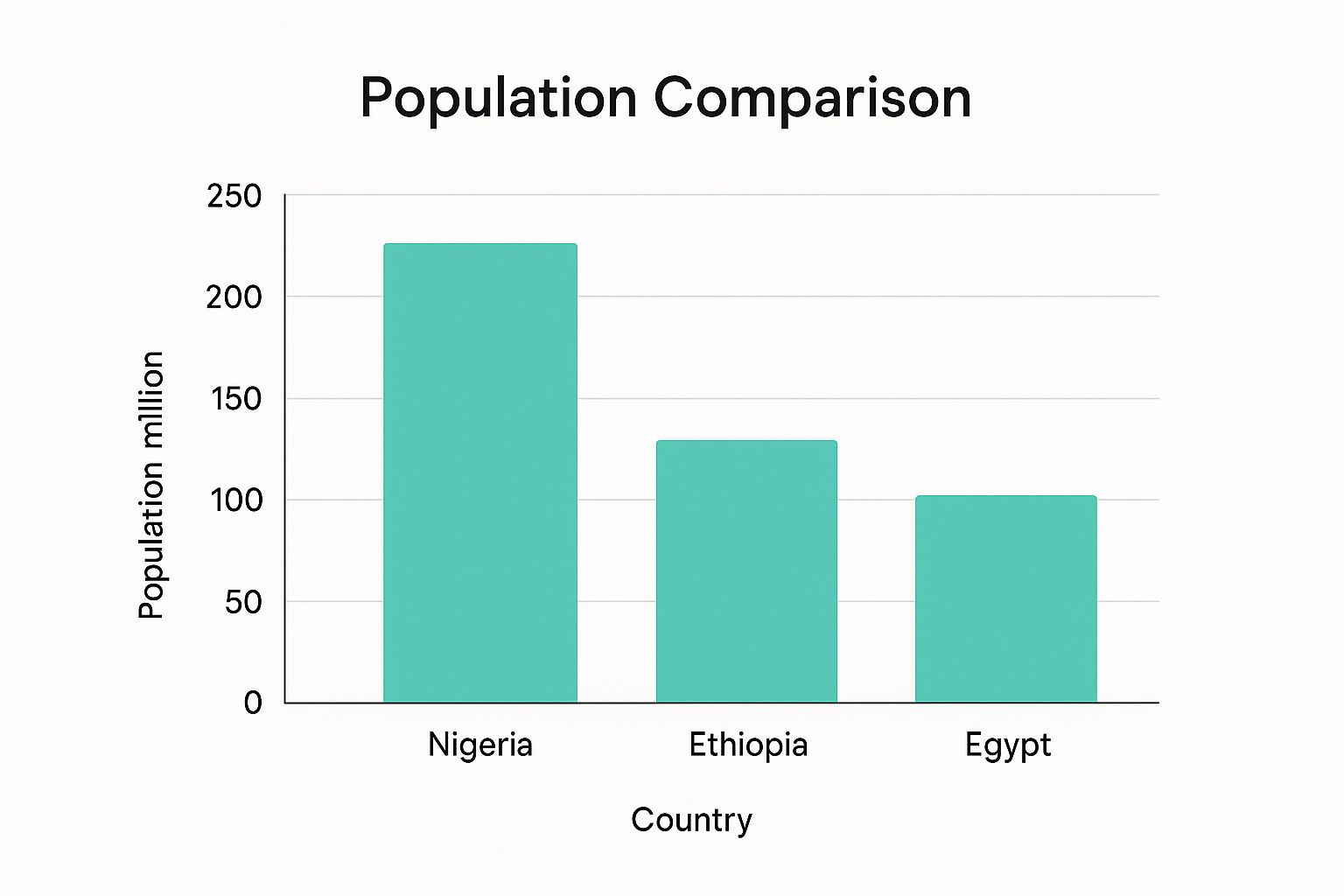
As you can see, Nigeria sits comfortably in the top spot as the continent's population leader, with Ethiopia and Egypt following behind.
A Quick Look at Population Dynamics
Africa's population is growing fast—really fast. Projections show the total number of people on the continent will hit around 1.55 billion by July 1, 2025. This incredible expansion, fueled by a youthful demographic and high birth rates, makes Africa the second most populous continent on the planet.
This growth isn't just a number; it has huge implications for everything from global demographics to resource management. If you're interested in digging deeper into these trends, you can discover more insights about Africa's population dynamics and see what the future might hold.
Common Questions About Africa's Countries
When you start digging into the geography of Africa, a few questions always seem to surface. Sorting these out early on helps build a solid foundation and clears up some common mix-ups. Let's tackle them head-on.
Think of this as your quick-reference guide for the continent's most interesting geographical facts.
How Many Countries Are There in Africa?
The straight answer is 54 universally recognized sovereign countries. This is the official count that organizations like the United Nations work with.
You might sometimes see a different number floating around. That's usually because some sources include dependent territories or disputed regions like Western Sahara. For learning the map, sticking to the 54 recognized nations is the way to go.
What Is the Newest Country in Africa?
Africa's newest nation is South Sudan, which officially became independent from Sudan on July 9, 2011.
This historic moment came after a referendum where the people overwhelmingly voted to form their own country. With its capital in Juba, South Sudan's creation is one of the most significant changes to the map of Africa in recent memory.
Which African Country Has Three Capitals?
South Africa holds a unique distinction: it's the only country in the world with three capital cities. This setup isn't random; it's a direct result of its complex political history and the compromises made along the way.
- Pretoria is the administrative capital, where the executive branch of the government sits.
- Cape Town is the legislative capital, home to the nation's Parliament.
- Bloemfontein serves as the judicial capital, where the Supreme Court of Appeal is based.
This three-capital system is more than just a great trivia fact. It's a fascinating look into how geography can reflect a nation's story of negotiation and power-sharing.
What Is the Best Way to Memorize African Countries?
Honestly, there's no single magic trick. The most effective approach is to combine a few proven methods. Breaking the continent down into smaller, manageable regions—just like we've done in this guide—makes the task feel much less overwhelming.
From there, it's all about active recall. Repetition with tools like flashcards is a classic for a reason. But to really make it stick, you need to make it engaging. Challenge yourself with an interactive countries map quiz to turn practice into a game. Creating mental hooks by associating a country with its flag or a unique fact also works wonders for your memory.
At EarthChasers, we believe learning geography should be an adventure, not a chore. Our 3D geography game transforms the way you explore the world, making it fun and interactive. Ready to start your journey? Visit us at https://earthchasers.com to play.
